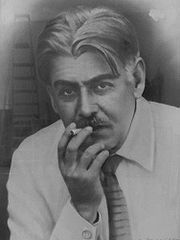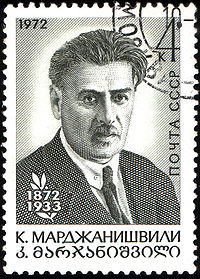
Kote Marjanishvili
Encyclopedia

Russification
Russification is an adoption of the Russian language or some other Russian attributes by non-Russian communities...
name Konstantin Aleksandrovich Mardzhanov (May 28, 1872 – April 17, 1933) was a Georgian
Georgia (country)
Georgia is a sovereign state in the Caucasus region of Eurasia. Located at the crossroads of Western Asia and Eastern Europe, it is bounded to the west by the Black Sea, to the north by Russia, to the southwest by Turkey, to the south by Armenia, and to the southeast by Azerbaijan. The capital of...
theater director regarded as an important contributor to the pre- and post-revolutionary evolution of Georgian, Russia
Russia
Russia or , officially known as both Russia and the Russian Federation , is a country in northern Eurasia. It is a federal semi-presidential republic, comprising 83 federal subjects...
n and Soviet
Soviet Union
The Soviet Union , officially the Union of Soviet Socialist Republics , was a constitutionally socialist state that existed in Eurasia between 1922 and 1991....
stages. One of the most prestigious and professional of Georgia’s directors, he was particularly famous for his lavish and massive theater shows.
Early career

Kvareli
Qvareli is a town in northeastern in Kakheti Province, Georgia. Located in the Alazani Valley, near the foothills of the Greater Caucasus Mountains, it was the birthplace of Georgian author Ilia Chavchavadze, whose fortified house is preserved as a local museum.The area is in the center of the...
, eastern Georgia, then part of the Tiflis Governorate
Tiflis Governorate
Tiflis Governorate was one of the guberniyas of the Russian Empire with its centre in Tiflis . In 1897 it constituted 44,607 sq. kilometres in area and had a population of 1,051,032 inhabitants...
, Imperial Russia. After acting and directing in his native country from 1893 to 1909, he went to Russia proper, Russifying his surname as Mardzhanov.
He worked for Russian provincial theaters as an actor, then as a director, until he established himself in the Moscow
Moscow
Moscow is the capital, the most populous city, and the most populous federal subject of Russia. The city is a major political, economic, cultural, scientific, religious, financial, educational, and transportation centre of Russia and the continent...
Nezlobin troupe in 1906 and later co-founded the Georgian Drama Studio with Alexander Yuzhin
Alexander Yuzhin
Alexander Ivanovich Yuzhin was a stage name of the Georgian Prince Sumbatov , who dominated the Malyi Theatre of Moscow at the turn of the 19th and 20th centuries. He was best known for the Romantical parts in the dramas by Schiller and Victor Hugo but also penned a number of plays himself...
. He quickly gained a reputation as one of the most talented followers of the well-known Russian actor and theater director Konstantin Stanislavsky (1863-1938). As a director, Marjanishvili’s main technique was to guide the actor in finding an instinctive path to realizing "outer truth". In 1910, his versatility was recognized by Stanislavsky himself who invited him at the same time as Edward Gordon Craig
Edward Gordon Craig
Edward Henry Gordon Craig , sometimes known as Gordon Craig, was an English modernist theatre practitioner; he worked as an actor, director and scenic designer, as well as developing an influential body of theoretical writings...
to open up the repertoire and production techniques of the Moscow Art Theatre
Moscow Art Theatre
The Moscow Art Theatre is a theatre company in Moscow that the seminal Russian theatre practitioner Constantin Stanislavski, together with the playwright and director Vladimir Nemirovich-Danchenko, founded in 1898. It was conceived as a venue for naturalistic theatre, in contrast to the melodramas...
. There he staged works by Hamsun
Knut Hamsun
Knut Hamsun was a Norwegian author, who was awarded the Nobel Prize in Literature in 1920. He was praised by King Haakon VII of Norway as Norway's soul....
and Ibsen
Henrik Ibsen
Henrik Ibsen was a major 19th-century Norwegian playwright, theatre director, and poet. He is often referred to as "the father of prose drama" and is one of the founders of Modernism in the theatre...
and assistant-directed the Nemirovich-Danchenko
Nemirovich-Danchenko
-People:*Vladimir Nemirovich-Danchenko , Russian playwright and theatre director* Vasily Nemirovich-Danchenko , Russian novelist and journalist, Vladimir Nemirovich-Danchenko's brother....
Brothers Karamazov (1910) and the Craig Hamlet
Hamlet
The Tragical History of Hamlet, Prince of Denmark, or more simply Hamlet, is a tragedy by William Shakespeare, believed to have been written between 1599 and 1601...
(1911). Fascinated by Craig’s stylized manner of using puppets, Marjanishvili temporarily returned to Georgia to stage Oedipus Rex in a similar spirit. In 1913, he broke with Stanislavsky due to his left-wing sympathies and his interest in decadence
Decadent movement
The Decadent movement was a late 19th century artistic and literary movement of Western Europe. It flourished in France, but also had devotees in England and throughout Europe, as well as in the United States.-Overview:...
, and organized the eclectic "Free Theater", where he staged opera, operetta, drama and pantomime. The enterprise, notable for its ties with the composer Sergei Rachmaninoff
Sergei Rachmaninoff
Sergei Vasilievich Rachmaninoff was a Russian composer, pianist, and conductor. Rachmaninoff is widely considered one of the finest pianists of his day and, as a composer, one of the last great representatives of Romanticism in Russian classical music...
and the singer Feodor Chaliapin
Feodor Chaliapin
Feodor Ivanovich Chaliapin was a Russian opera singer. The possessor of a large and expressive bass voice, he enjoyed an important international career at major opera houses and is often credited with establishing the tradition of naturalistic acting in his chosen art form.During the first phase...
, and for its Georgian-type choreography, was rendered abortive in a year due largely to financial problems. He then moved to Rostov-on-Don
Rostov-on-Don
-History:The mouth of the Don River has been of great commercial and cultural importance since the ancient times. It was the site of the Greek colony Tanais, of the Genoese fort Tana, and of the Turkish fortress Azak...
, where he directed the local theater from 1914 to 1915.
Post-revolution years
Marjanishvili’s 1917 production of Oscar WildeOscar Wilde
Oscar Fingal O'Flahertie Wills Wilde was an Irish writer and poet. After writing in different forms throughout the 1880s, he became one of London's most popular playwrights in the early 1890s...
’s Salomé
Salome (play)
Salome is a tragedy by Oscar Wilde.The original 1891 version of the play was in French. Three years later an English translation was published...
was a true triumph and continued to be staged during the tumultuous years of revolution
Russian Revolution of 1917
The Russian Revolution is the collective term for a series of revolutions in Russia in 1917, which destroyed the Tsarist autocracy and led to the creation of the Soviet Union. The Tsar was deposed and replaced by a provisional government in the first revolution of February 1917...
and civil war
Russian Civil War
The Russian Civil War was a multi-party war that occurred within the former Russian Empire after the Russian provisional government collapsed to the Soviets, under the domination of the Bolshevik party. Soviet forces first assumed power in Petrograd The Russian Civil War (1917–1923) was a...
in Kiev
Kiev
Kiev or Kyiv is the capital and the largest city of Ukraine, located in the north central part of the country on the Dnieper River. The population as of the 2001 census was 2,611,300. However, higher numbers have been cited in the press....
(Kiyv, Ukraine
Ukraine
Ukraine is a country in Eastern Europe. It has an area of 603,628 km², making it the second largest contiguous country on the European continent, after Russia...
), Moscow, Petrograd (St. Petersburg, Russia), and Tiflis (Tbilisi, Georgia). Marjanishvili’s simultaneous experiments with festive staging in Rostov-on-Don (1914-15) and Petrograd (1916-17) led him to coordinate the mass spectacle Toward a Worldwide Commune (co-directed by Nikolai Petrov
Nikolai Petrov
Nikolai Arnoldovich Petrov was a Russian pianist.Petrov was born in Moscow, the son of the cellist Arnold Ferkelman and the grandson of the operatic bass Vasily Rodionovich Petrov, and began learning the piano at the age of three...
, Sergei Radlov, Vladimir Solovyov and Adrian Piotrovsky
Adrian Piotrovsky
Adrian Ivanovich Piotrovsky was a Russian dramaturge, responsible for creating the synopsis for Prokofiev’s ballet Romeo and Juliet. He was the "acknowledged godfather" of the Theatre of Working Youth ....
, 1920). For years, he also worked in films (1916-28).
Returning to the recently Sovietized Georgia in 1922, he led the Rustaveli Theater in Tbilisi. By that time, the energetic young director Sandro Akhmeteli
Sandro Akhmeteli
Sandro Akhmeteli was a Georgian theater director whose innovative conceptions and skill at mass scenes profoundly influenced the evolution of Soviet and post-Soviet Georgian theater tradition...
had also returned to Tbilisi to lead the younger actors in a coup against the establishment. The two men collaborated with respect and unease, but Akhemeteli’s nearly despotic rule over his artistic corporation "Duruji" proved too violent for Marjanishvili whose production had become more restrained, motivated by his own conviction that "there’s enough suffering in life without showing it on the stage." In 1926, he and part of the company left to form a provincial touring theatre, centered on Kutaisi
Kutaisi
Kutaisi is Georgia's second largest city and the capital of the western region of Imereti. It is 221 km to the west of Tbilisi.-Geography:...
and Batumi
Batumi
Batumi is a seaside city on the Black Sea coast and capital of Adjara, an autonomous republic in southwest Georgia. Sometimes considered Georgia's second capital, with a population of 121,806 , Batumi serves as an important port and a commercial center. It is situated in a subtropical zone, rich in...
, leaving Akhmeteli in sole control of the Rustaveli Theater. The new theater came to be known as The Second State Georgian Theater and would eventually be named the Marjanishvili Theater
Marjanishvili Theater
Kote Marjanishvili State Drama Theatre is the second state theatre in Tbilisi, Georgia. Originally founded in Kutaisi in 1928 by Kote Marjanishvili, the theatre moved to Tbilisi in 1930 to Brothers Zubalashvili Public House, the building it occupies up to date.The roots of Georgian theatre date...
after its founder (1933). The theater is still functional in Tbilisi and continues Marjanishvili’s eclectic and somewhat conformist traditions.
In his later years, Marjanishvili worked at the Korsh Theater (Театр Корша) (1931-1932), the Maly Theater
Maly Theatre (Moscow)
Maly Theatre is a drama theater in Moscow, Russia. Established in 1806 and operating on its present site on the Theatre Square since 1824, the theatre traces its history to the Moscow University drama company, established in 1756...
(Малый театр) and the Operetta Theater in Moscow (1933). Marjanishvili’s new repertoire was largely Russian and conformed to Bolshevik
Bolshevik
The Bolsheviks, originally also Bolshevists , derived from bol'shinstvo, "majority") were a faction of the Marxist Russian Social Democratic Labour Party which split apart from the Menshevik faction at the Second Party Congress in 1903....
doctrine, which won him awards at the Moscow Drama Olympiad of 1930. Yet, menacing charges against Marjanishvili soon began to appear in the Soviet
Soviet Union
The Soviet Union , officially the Union of Soviet Socialist Republics , was a constitutionally socialist state that existed in Eurasia between 1922 and 1991....
press. He died of illness on 17 April 1933 before the worsening political climate led to the Stalinist Great Purge
Great Purge
The Great Purge was a series of campaigns of political repression and persecution in the Soviet Union orchestrated by Joseph Stalin from 1936 to 1938...
which would take the life of Marjanishvili’s erstwhile collaborator and rival Sandro Akhemeteli in 1937.
Filmography
- Before the HurricaneBefore the HurricaneBefore the Hurricane is a 1924 Georgian black-and-white silent film directed by Kote Marjanishvili based on a script by Shalva Dadiani.-Cast:* L. Kavsadze as Gijua...
, 1924 - KrazanaKrazanaKrazana is a 1928 Georgian black-and-white silent film directed by Kote Marjanishvili based on the novel The Gadfly by Ethel Lilian Voynich.-Cast:* Nato Vachnadze as Jema* I. Merabishvili as Arthur...
, 1926 - Amok, 1927

